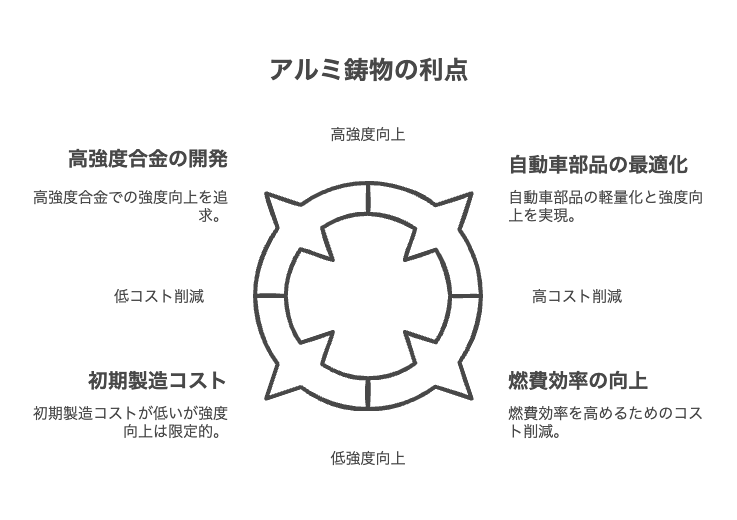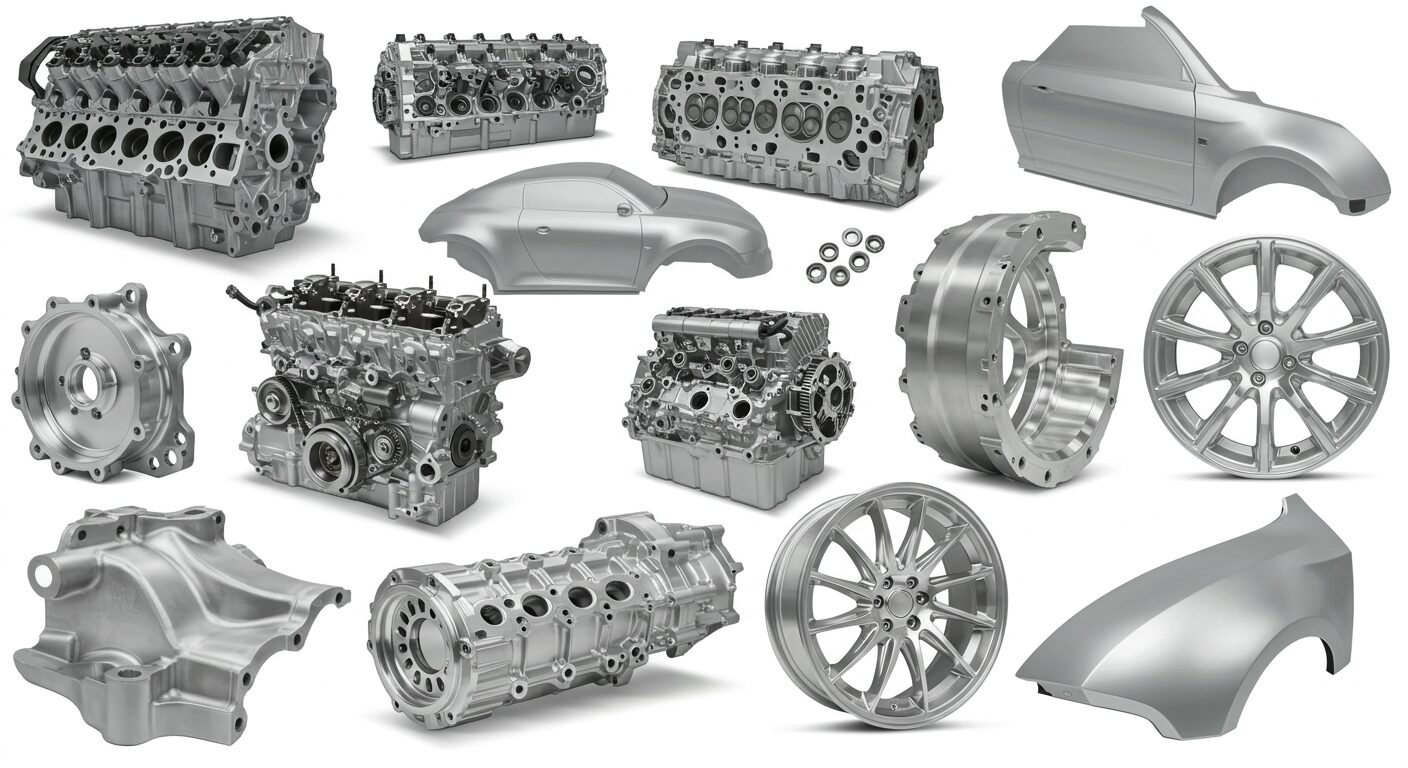1. Steering parts
Traditionally, iron was often used for steering parts tie rod ends to ensure strength. In recent years, advances in high-strength aluminum forging technology have led to the replacement of aluminum with aluminum. High-strength aluminum forging is a technology that improves strength through a unique high-speed constant temperature forging process, achieving strength comparable to that of iron. This makes it possible to ensure the necessary strength while reducing the weight of steering parts. As the world’s first aluminum tie rod end for mass-produced vehicles, it contributes to improving the fuel efficiency and driving range of EVs [1].
2. Body structure
Tesla has introduced a gigantic die-casting machine called the “Giga Press” to manufacture large car parts from aluminum, significantly reducing the weight of the car body [2]. Die casting is a casting method in which molten metal is pressed into a mold, and is attracting attention as a technology that contributes to reducing the weight of cars. Aluminum alloys are often used as materials for die casting because they have low density and excellent corrosion resistance and workability. Die casting can produce parts without seams, making it possible to reduce the weight of parts while maintaining their high rigidity. In addition, even parts with complex shapes can be molded with high precision by pressing metal into a mold [2].
3. Housing
Magnesium die casting is used for the housing of the unit part of electric assist bicycles [2]. Magnesium alloy, which has a higher specific gravity and higher rigidity than aluminum, is used in parts that require strength, achieving both weight reduction and strength retention.
As can be seen from these examples, aluminum alloys are used in various parts of automobiles and contribute to weight reduction. In particular, aluminum plays an important role in EVs to suppress the weight increase caused by the battery and extend the driving range [1, 3].
Source:
1 https://www.t-turret.co.jp/forging/product/aluminum/ev/
2 https://diecasting.atryz.co.jp/knowledge/knowledge_9/
3https://www.shisaku.com/blog/anatomy/post-100.html
Technical trends in aluminum casting automotive parts
Aluminum casting technology, which drives the weight reduction and strength of automotive parts, is constantly evolving. Below are some technological trends that have attracted particular attention in recent years.
Development of high-strength alloys
In order to further reduce the weight and increase the strength of automotive parts, new alloy components and composite materials are being actively developed. For example, alloys with improved strength and heat resistance have been developed by adding silicon and magnesium to aluminum. In addition, composite materials such as carbon fiber reinforced aluminum (CFRA) are also being researched, and it is expected that they will achieve both light weight and high strength. These high-strength alloys are increasingly being applied to parts used in harsh environments, such as engine parts and body structural members.
Evolution of Casting Technology
Casting technology is also evolving to produce higher quality and more complex parts. Mold production using 3D printing technology makes it possible to produce parts with complex shapes that were difficult to produce using conventional manufacturing methods more quickly and at lower cost. Precision casting technology and thin-wall technology also contribute to lighter parts and higher performance. In addition, smart factories and quality control systems using IoT (Internet of Things) have been introduced, and the automation of the casting process and stabilization of quality are progressing.
Evolution of Joining Technology
Joining aluminum cast parts to other parts is essential to incorporate them into automobiles. Joining technology has also evolved, and various technologies have been developed, such as friction stir welding (FSW), adhesive joining, and dissimilar material joining. FSW is a method of joining metals using frictional heat, which can achieve high-strength and airtight joints. Adhesive joining is a method of joining parts using adhesives, which contributes to weight reduction. Dissimilar material joining is a method of joining aluminum and other materials (e.g., steel and resin), which improves the functionality of the parts.
Future Outlook
The technology of aluminum cast automotive parts is expected to continue to evolve in the following directions.
- Further weight reduction and strength: The development of new alloys and composite materials, the evolution of casting technology, and the sophistication of joining technology will enable further weight reduction and strength of automotive parts.
- Development of parts for electrification and autonomous driving: With the spread of electric vehicles and autonomous driving cars, the development of new parts such as battery cases, motor housings, and sensor parts is required. Aluminum casting technology is expected to contribute to making these parts lighter and stronger.
- Efforts to reduce environmental impact: Efforts to reduce environmental impact, such as reducing energy consumption in the aluminum casting manufacturing process and developing recycling technologies, will accelerate.
In light of these technological development trends, Yamato Light Metals will utilize its strengths, such as cost reduction through production in Vietnam, high quality through Japanese-style management, and local procurement in Vietnam, to provide high-quality aluminum casting parts that meet the needs of the automotive industry.
Manufacturers of aluminum casting auto parts
Introduction to major manufacturers
There are many manufacturers of aluminum casting auto parts both in Japan and overseas. Below, we will introduce some representative manufacturers, their strengths, areas of expertise, and major clients.
Alcoa:
A major American aluminum manufacturer, Alcoa provides aluminum products to a wide range of industries, including aerospace, automotive, and packaging. In the automotive field, Alcoa excels in the development of high-strength aluminum alloys, die-casting technology, and joining technology. Ford, GM, and Toyota are its major clients.
Lynden:
A Canadian automotive parts manufacturer, Alcoa specializes in die-casting parts. It offers a wide range of products, including engine blocks, transmission cases, and chassis parts, and mainly deals with North American automakers.
UACJ:
A Japanese aluminum rolling and processing manufacturer, UACJ provides aluminum products to a wide range of fields, including automotive, aircraft, and electronics. In the automotive field, Alcoa excels in heat exchanger materials and structural materials, and mainly deals with Japanese automakers.
Ahresty:
A Japanese die-casting manufacturer offering a wide range of products including automotive parts, motorcycle parts, and industrial machinery parts. The company has strengths in manufacturing technology for high-quality die-casting products, and does business with domestic and foreign automobile manufacturers.
Contributions of manufacturers
Aluminum casting parts manufacturers are developing and working on various technologies to contribute to the weight reduction, strength, and environmental load reduction of automobiles.
Technology development examples that contribute to weight reduction and strength:
- Development of high-strength aluminum alloys: By developing alloys with higher strength than conventional aluminum alloys, it is possible to reduce the weight of parts.
- Evolution of die-casting technology: By developing die-casting technology that can manufacture parts with more complex shapes, we are contributing to the weight reduction and improved functionality of parts.
- Development of joining technology: By developing technology to join aluminum with other materials, we are able to improve the strength of parts and add a variety of functions.
Examples of initiatives that contribute to reducing environmental impact:
- Utilization of recycled materials: By actively utilizing recycled aluminum materials, we are contributing to the effective use of resources and the reduction of CO2 emissions.
- Reducing environmental impact in manufacturing processes: We are promoting initiatives to reduce environmental impact, such as reducing energy consumption and waste in manufacturing processes.
Through these technological developments and initiatives, aluminum casting parts manufacturers are making a significant contribution to the development of the automotive industry.
まとめ
Increasing the weight and strength of aluminum castings is essential to improving fuel efficiency, reducing CO2 emissions, and improving driving performance. Automobile manufacturers such as Toyota Motor Corporation and Ford are actively adopting aluminum castings and enjoying various benefits from their lightweight and high strength.
Aluminum casting technology is constantly evolving, with the development of high-strength alloys, the evolution of casting technology, and the sophistication of joining technology. In the future, it will continue to contribute to solving issues such as further weight reduction and high strength, responding to electrification and autonomous driving, and reducing environmental impact.
Aluminum casting will continue to expand its potential as an important material that supports the sustainable development of the automotive industry.



